Counting and rhythm
To structure the movement of music in time, the staff is divided into measures or bars by bar lines.

The length of the bars or measures depends on the time signature. A 4/4 time signature tells you that each bar has the length of four quarter notes. Quarter notes are depicted by a full note head and the attached stem.

The four quarter beats of the same bar can be filled with different note lengths. One whole note has the duration of four quarter beats and thus can fill out the whole bar. It is symbolized by a hollow note head without a note. To play this whole note, count 1 – 2 – 3 – 4 after pressing down the piano key, then move on to the next note.
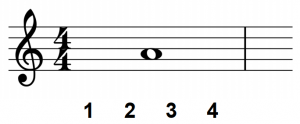
A whole note contains two half notes, each with the duration of two quarter beats. Half notes are depicted as a hollow note head with a plain note stem. To play these two half notes count 1 – 2 after pressing down the piano key for the first note, then move on to the next note and count 3 – 4.

The next subdivision is quarter notes, which you have already seen above. A whole note contains four quarter notes, a half note contains two quarter notes. To play these four quarter notes count 1 after pressing down the key for the first note, then move on to the next note on beat 2, then the next note on beat 3 and then the last note on beat 4.

Quarter notes can be subdivided into even smaller fractions. Each quarter note contains two eighth notes. The whole bar in 4/4 contains 8 eighth notes. Eighth notes are depicted by a full note head with a stem that has one flag attached. If they appear in groupings, the note flags of the single notes are replaced by a black line that connects the individual note stems.
To play these four quarter notes count 1 after pressing down the key for the first note, then move on to the next note on the 1 and, then the next note on beat 2, the next note on the 2 and. Keep playing and counting until 4 and.

The next subdivision is sixteenth notes. Each eighth note contains two sixteenth notes, each quarter note contains four sixteenth notes. The whole bar in 4/4 contains 16 sixteenth notes. Sixteenth notes are depicted by a full note head with a stem that has a two flags attached. If they appear in groupings, the note flags of the single notes are replaced by two black lines that connect the individual note stems. To play these 16 sixteenth notes count 1-e-and-a, 2-e-and-a, 3-e-and-a, 4-e-and-a.

So far you have subdivided the whole note by factors of 2, 4, 8 and 16. You can also subdivide the quarter note by 3, which will create eighth note triplets. They look the same as eighth notes, but come in groupings of three with a 3 written above the connecting line.
To play these eighth note triplets, count either 1-and-a, 2-and-a, 3-and-a, 4-and-a , or 1-trip-let, 2-trip-let, 3-trip-let, 4-trip-let.

For every note value you can find a corresponding rest or break. These rests have exactly the same length as their related notes and are counted just the same. Here is a list of the breaks with their musical symbols. 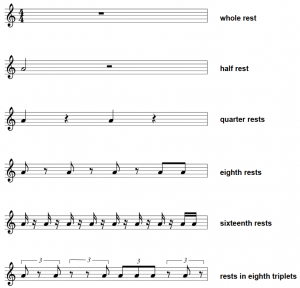
Finally there are dotted notes. If you see a dot after a note, it means that the note length is increased by half of its original value. For example:

A dotted half note has three beats to it – two beats for the half note and one for the dot. A dotted quarter note has one and a half beats (or three eighth beats) to it – one for the quarter note and another half for the dot.
Time signatures
The time signature defines how many beats there are within each bar of a piece of music. It is written right at the beginning of the first line of the notation just after the clef. So far you have seen only the 4/4 time signature, meaning that there are four quarter notes within each bar.
There are other time signatures as well. You can easily read them in the following way: the upper number tells you the number of beats of the bar, and the lower number shows the value or length for each of these beats.
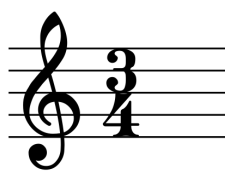 If you have a 3/4 time signature, you have three beats per bar, each with the length of a quarter note.
If you have a 3/4 time signature, you have three beats per bar, each with the length of a quarter note.
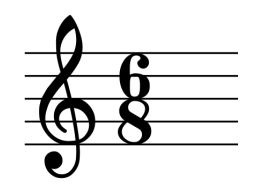 A 6/8 time signature tells you that you have six eighth notes within each bar.
A 6/8 time signature tells you that you have six eighth notes within each bar.
Other common time signatures are 2/2, 2/4 and 12/8.
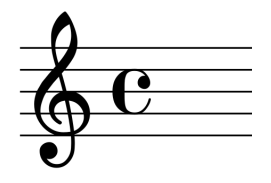
If you see a bold C instead of the time signature it means Common Time, which is a 4/4 time signature.
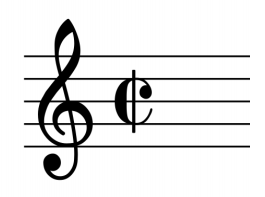
A bold C with a vertical line in the middle denotes a 2/2 time signature (Cut-Time or Cut-Common Time).
Key signatures
The last thing you need to read piano sheet music know are key signatures. The key of a piece of music denotes which of the twelve notes is the root note or tonal center of the music being played. A piece in the key of C major will have the note C as its root and will be composed mainly of the notes of the C major scale. A piece in the key of D major will have D as its root and will be composed mainly of the notes of the D major scale.
To understand the concept of key signatures, take a look at the D major scale. It consists of the following notes:

Because the F sharp and C sharp notes are part of the D major scale, it would be redundant to write a sharp sign next to each F and C throughout the whole piece written in D major. Instead the two sharps of the key are notated only once, right at the beginning of the sheet music, and are repeated at the beginning of each line. The D major scale would look like this if written with the key signature of
D major:

The two sharps at the beginning tell you that you have to play F sharp every time you find an F and C sharp every time you find a C throughout the whole piece. Generations of students forget this little detail while playing through a piece and have to correct themselves or get a frown from their teacher – surely the same will happen to you!
Additional sharps or flats (also called accidentals) can still be added throughout the piece of music, no matter what key it is written in. If you come across an extra sharp or flat, you need to know that it is valid only for the length of the bar it appears in. As soon as the next bar starts, all notes are to be played again as the key signature indicates. Besides sharps and flats, there is a third accidental to indicate that a previous sharp or flat is canceled and the note is to be played in its natural pitch. Again, the natural sign is valid only during the bar it appears in, unless written in the key signature.

In this example, the second note is a C sharp because of the key signature. The third note is a C natural because the sharp has been cancelled by the natural sign. In the second bar, it is C sharp again, because the natural sign is acting only within the first bar.

